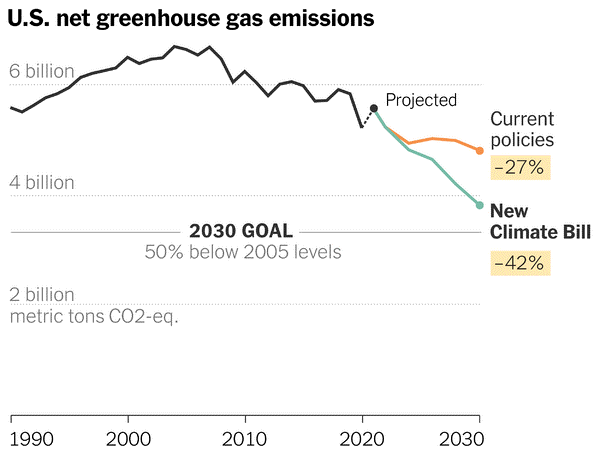|
|
By German Lopez
|
|
Good
morning. The climate bill will make cleaner energy cheaper
for everyone.
|
|
|
|
|
|
|
|

|
|
Solar panels in Grafton, Mass.Tony Cenicola/The New York Times
|
|
|
Ditching
fossil fuels
|
|
By the end of today, Congress will likely have passed the
biggest climate bill in U.S. history.
|
|
This
newsletter has already covered the bills main goals and the back story of how it came together. Today, I want to get more detailed and explain how it will
help people and businesses abandon the dirty energy that
contributes to global warming.
|
|
What's in the bill
|
|
The bills climate provisions are mostly a collection of
subsidies for energy that does not emit any carbon, like
solar, wind and nuclear power. Without those subsidies,
polluting fossil fuels are often still cheaper. The
subsidies try to give cleaner energy an edge.
|
|
I don't mean this as an exaggeration: This really changes
everything, said Jesse Jenkins, a climate policy expert at
Princeton University. It is effectively going to shift the
financial case away from dirty energy toward clean energy
for everyone.
|
|
For consumers, the subsidies will reduce the prices of
electric vehicles, solar panels, heat pumps and other
energy-efficient home improvements. You
can claim the subsidies through tax filings; as a separate
rebate if you don't file taxes; or, in some cases,
immediately when you make a purchase.
|
|
Let's say you want to buy one of the cheaper, new electric
vehicles on the market right now, priced around $40,000.
To get the subsidy, you will first want to make sure
the car qualifies; the bill requires, among other things,
that the vehicles are assembled in North America. (Ask the
car dealer or manufacturer to find out.) Then, make sure
that you qualify; individual tax filers cannot make more
than $150,000 a year, for example.
And, given high demand, you might have to order a car
well in advance.
|
|
If you meet the requirements, you can claim up to $7,500 in
tax credits — effectively bringing the price of a
$40,000 vehicle to $32,500.
|
|
That is the tax credit for new cars.
For used cars, there will be a smaller tax credit of
up to $4,000. The
goal of both credits is to even the playing field: Cars that
burn fossil fuels are still generally cheaper than electric
vehicles. With
the credits, electric cars will be much closer in price to,
if not cheaper than, similar nonelectric vehicles.
|
|
For home improvements, the process will be different, but the
basic idea is similar. For a typical $20,000 rooftop solar
installation, tax credits will cut the price by up to
$6,000. There are also subsidies for heat pumps, electric
stoves, and other energy-efficiency projects. The hope is to
make all these changes much more affordable for everyday
Americans, leading to less reliance on fossil fuels and
expanding the market for cleaner energy.
|
|

|
|
President Biden
touring wind turbines in Colorado last year.Doug Mills/The New York Times
|
The bill includes a slew of benefits
for businesses, too. For example, they will be able to claim
credits to replace traditional cars with electric ones, saving as
much as 30 percent on each vehicle's cost.
|
|
Another set of incentives will
encourage businesses to build and use cleaner energy. Similar
credits have existed in the past, but they often expired after one
or two years — producing unpredictable boom-and-bust cycles
for investors and businesses.
This time, Congress is establishing the credits for at
least a decade, helping create more certainty. And the credits
will for the first time apply to publicly owned utilities and
nonprofits, a large segment of U.S. electricity providers.
|
|
The bill does
include a compromise: It requires more leasing of federal lands
and waters for oil and gas projects.
Senator Joe Manchin, the most conservative Democrat in the Senate, demanded this provision.
|
|
But experts say
that it will have only a modest impact in terms of greenhouse gas
emissions. Overall, the bill will subtract at least 24 tons of
carbon emissions for each ton of emissions that the oil and gas
provision adds, according to Energy Innovation, a think tank.
|
|
It's a trade-off, my colleague Coral Davenport, who covers
energy and environmental policy, told me. But
in terms of emissions impact, it's a good deal.
|
|
The bottom line
|
|
The bill will make cleaner energy and electric vehicles much
cheaper for many Americans. Over
time, it will also likely make them more affordable for the rest
of the world, as more competition and innovation in the U.S. lead
to cheaper, better products that can be shipped worldwide.
|
|
And it will move America close to
President Biden's goal of cutting greenhouse emissions to half
their peak by 2030, according to three independent analyses.
|

Modeling for the new
climate bill is based on draft legislation from July 27, 2022
|
The bill is also a sign that the
U.S. is starting to take climate change seriously. That will give
American diplomats more credibility as they ask other countries,
such as China and India, to do the same.
|
|
Still, many scientists believe the
U.S. will eventually need to do more to prevent severe damage from
climate change. This
bill is only the beginning, said Leah Stokes, a climate policy
expert at the University of California, Santa Barbara.
|
|